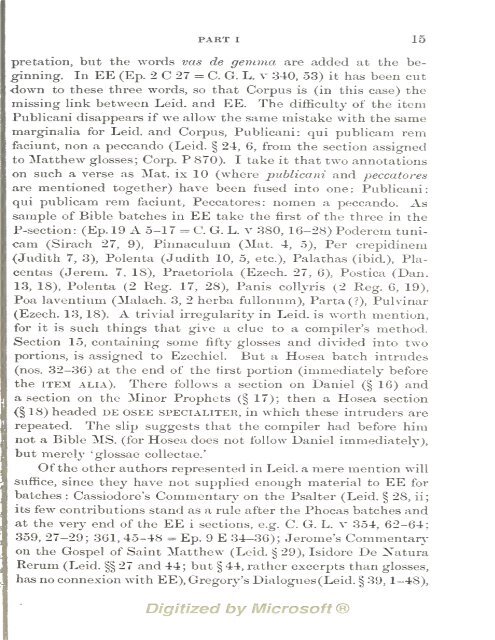the corpus, épinal, erfurt and leyden glossaries, viii - World eBook ...
the corpus, épinal, erfurt and leyden glossaries, viii - World eBook ...
the corpus, épinal, erfurt and leyden glossaries, viii - World eBook ...
You also want an ePaper? Increase the reach of your titles
YUMPU automatically turns print PDFs into web optimized ePapers that Google loves.
PART I 15<br />
tation, but <strong>the</strong> words vas de gemma are added at <strong>the</strong> be-<br />
ining. In EE (Ep. 2 C 27 = C. G. L. v 340, 53) it has been cut<br />
\vn to <strong>the</strong>se three words, so that Corpus is (in this case) <strong>the</strong><br />
issing link between Leid. <strong>and</strong> EE. The difficulty of <strong>the</strong> item<br />
ublicani disappears if we allow <strong>the</strong> same mistake with <strong>the</strong> same<br />
marginalia for Leid. <strong>and</strong> Corpus, Publicani: qui publicam rem<br />
faciunt, non a pecc<strong>and</strong>o (Leid. § 24, 6, from <strong>the</strong> section assigned<br />
to Mat<strong>the</strong>w glosses; Corp. P 870). I take it that two annotations<br />
on such a verse as Mat. ix 10 (where publicani <strong>and</strong> peccatores<br />
are mentioned toge<strong>the</strong>r) have been fused into one: Publicani:<br />
qui publicam rem faciunt, Peccatores: nomen a pecc<strong>and</strong>o. As<br />
sample<br />
of Bible batches in EE take <strong>the</strong> first of <strong>the</strong> three in <strong>the</strong><br />
P-section: (Ep. 19 A 5-17 = C. G. L. v 380, 16-28) Poderem tunicam<br />
(Sirach 27, 9), Pinnaculum (Mat. 4, 5), Per crepidinem<br />
(Judith 7, 3), Polenta (Judith 10, 5, etc.), Palathas (ibid.), Placentas<br />
(Jerem. 7, 18), Praetoriola (Ezech. 27, 6), Postica (Dan.<br />
13, 18), Polenta (2 Reg. 17, 28), Panis collyris (2 Reg. 6, 19),<br />
Poa laventium (Malach. 3, 2 herba fullonum), Parta(?), Pulvinar<br />
(Ezech. 13, 18). A trivial irregularity in Leid. is worth mention,<br />
for it is such things that give a clue to a compiler's method.<br />
Section 15, containing some fifty glosses <strong>and</strong> di\'ided into two<br />
portions, is assigned to Ezechiel. But a Hosea batch intrudes<br />
(nos. 32-36) at <strong>the</strong> end of <strong>the</strong> first portion (immediately before<br />
<strong>the</strong> ITEM ALIA). There follows a section on Daniel (§ 16) <strong>and</strong><br />
a section on <strong>the</strong> Minor Prophets (§ 17); <strong>the</strong>n a Hosea section<br />
{§ 18) headed de osee specialiter, in which <strong>the</strong>se intruders are<br />
repeated. The slip suggests that <strong>the</strong> compiler had before him<br />
not a Bible MS. (for Hosea does not follow Daniel immediately),<br />
but merely 'glossae collectae.'<br />
Of <strong>the</strong> o<strong>the</strong>r authors represented in Leid. a mere mention will<br />
suffice, since <strong>the</strong>y have not supplied enough material to EE for<br />
batches : Cassiodore's Commentary on <strong>the</strong> Psalter (Leid. § 28, ii;<br />
its few contributions st<strong>and</strong> as a rule after <strong>the</strong> Phocas batches <strong>and</strong><br />
at <strong>the</strong> very end of <strong>the</strong> EE i sections, e.g. C. G. L. v 354, 62-64;<br />
359, 27-29; 361, 45-48 =<br />
Ep. 9 E 34-36); Jerome's Commentarjon<br />
<strong>the</strong> Gospel of Saint Mat<strong>the</strong>w (Leid. § 29), Isidore De Natura<br />
Rerum (Leid. §§ 27 <strong>and</strong> 44; but § 44, ra<strong>the</strong>r excerpts than glosses,<br />
has no connexion with EE), Gregory's Dialogues (Leid. § 39, 1-48),

















